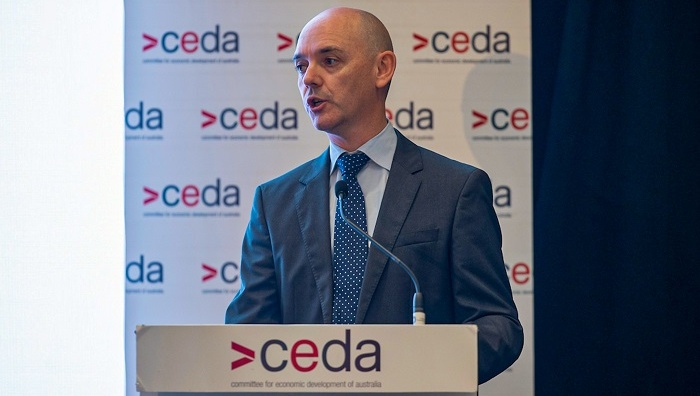
Adapted from a speech delivered by ARENA CEO Darren Miller to the Committee for Economic Development of Australia (CEDA) on 30 June 2022.
Hydrogen is not a new thing. Using electricity to manufacture hydrogen is not a new thing.
In fact, over 70 million tonnes of hydrogen is produced and consumed globally every year.
This photo shows a 135 MW electrolyser built and operated by NEL, the Norwegian electrolyser company, in 1953.

A plant worker inspects the Glomfjord electrolyser built in 1953.
The process of using an electric current to split water into its constituent elements – hydrogen and oxygen – dates back even further, to the early 1800’s.
But today, hydrogen is largely sourced from natural gas, and is used to make ammonia and to refine fossil fuels.
The production of hydrogen in this manner releases massive quantities of CO2 (which are not captured) and is responsible for around 2% of global emissions today.
This is roughly equivalent to the emissions from the global airline industry or the global shipping industry, and so an important target for decarbonisation in its own right – close to 1 billion tonnes of CO2 emissions annually must be taken seriously.
Therefore, to achieve net zero, we must either retrofit carbon capture and storage to these existing hydrogen production facilities or we must replace these facilities with hydrogen from electrolysers powered by renewable energy – so called green hydrogen.
However, it is hydrogen’s potential to solve the emissions reduction challenge across other sectors — industry, transport, manufacturing and electricity production — where the real interest lies.
The question is … is the interest in green hydrogen justified? Or is the hype greater than the hope?
In the almost four years that I have been leading ARENA, no single technology in the clean energy industry, and indeed in ARENA’s portfolio, has received more attention than green hydrogen.
To date, ARENA has invested $88 million in 35 hydrogen projects ranging from research and development projects with universities, to first-of-a-kind demonstrations. This year, in our $100 million hydrogen deployment round, we expect to reach financial close on two or three of Australia’s first large-scale electrolyser deployments.
While a 10 MW electrolyser would indeed be the largest of its kind in Australia so far, we’ve seen the ambition really grow to the extent that large-scale would now be a 300 MW electrolyser – some thirty times larger than those we’re currently working on.
We have been intentionally agnostic about the end uses of hydrogen – which are potentially many – as we have focused on the production side, where we have needed to gain experience, get early projects off the ground and focus attention on the full range of possibilities for this important decarbonisation technology.
We have supported studies and projects in the gas injection industry, transport, ammonia, export and power generation.
However, as the industry is maturing and more people are getting interested in hydrogen, the debate and attention must shift to the demand side. In which sectors and areas is hydrogen really needed? Where will it play a crucial role?
To answer these questions we must first understand hydrogen’s greatest challenges:
- Cost
- Competitors
- Logistics (transport and storage)
Taking each of these in turn …
Cost
Two years ago ARENA set out our observations and analysis that the cost of producing green hydrogen was between $6 to 9 per kg based on current electrolyser and renewable energy costs. Not much has changed in this time and we still haven’t built a sufficiently large electrolyser to demonstrate a benchmark cost.
We believe the 10 MW projects we are supporting will establish this cost range as broadly accurate. We are also seeing through feasibility studies that economies of scale of much larger projects could bring this cost down to around $4 per kg.
The pathway to reduce the cost of green hydrogen even further is fairly clear. Firstly, we need cheaper electrolysers and we need to gain experience and take costs out of the development and construction process. And secondly, we need a step change in the costs of building wind and solar farms to provide the cheap electricity that low cost green hydrogen requires. If we can achieve both, we can produce hydrogen at a cost competitive with fossil fuels.
This is why ARENA has chosen ultra-low cost solar as one of our strategic priorities.
The costs of solar, over $1000 per kilowatt to install, delivering electricity at an effective cost of around $50-60 per MWh, needs to decrease by ⅔ to generate electricity at an effective cost of $15-20 per MWh. Wind has an important complementary role to play but the potential cost reductions are not as significant as for solar.
Put simply, if we cannot achieve ultra-low cost solar electricity then we cannot have cheap green hydrogen.
The next issue to understand is hydrogen’s competitors.
To understand hydrogen’s need and potential success we must look at what it competes against.
Hydrogen will only have a role to play if it is more cost effective than the alternative solution for each and every end use case.
If battery electric vehicles are more cost effective than equivalent hydrogen fuel cell vehicles, then battery electric wins. If electric heat pumps are more cost effective than hydrogen for heating our homes, then heat pumps win.
And here there is good news and bad news.
The bad news for hydrogen is that its biggest competitor is also its biggest input cost: electricity. Cheap electricity is a requirement for cheap hydrogen but hydrogen also competes against electricity in many end uses, notably transport and heating.
Where a process or end use can be cost effectively electrified, then electricity is the preferred solution and hydrogen is unlikely to play a major role. Rather, it is those areas of heavy industry that require high temperatures or where hydrogen is a useful feedstock that will most naturally and readily support hydrogen.
The good news is, unlike natural gas which is subject to the global commodity cycle and can experience significant price volatility, hydrogen is a manufactured item with high upfront capital costs and low operating costs. So as the technology improves, costs come down and are locked in, so are not subject to the same volatility common for fossil fuels like oil and gas.
The third challenge is logistics – where do you make hydrogen, how do you transport it and how do you store it?
Hydrogen production works best at scale which is why there is growing interest in hubs where large-scale production and common infrastructure come together to drive costs down.
We know that storing and transporting hydrogen is challenging and we must find better ways to do both. While Australia is blessed with some of the best conditions for producing hydrogen, we suffer by being far away from the world’s biggest markets. By some estimates the costs of transporting hydrogen to key international markets may even exceed the costs of producing it.
It is the challenge of logistics that should concern us the most. There is little doubt we can achieve the production cost reductions we are aiming for. Similarly it is clear that hydrogen will be an important fuel and feedstock for many end uses as we head towards net zero.
What is less clear is how we build these new industries in Australia and how we overcome the storage and transport challenge.
AEMO just released its updated Integrated System Plan for 2022. Once again the ISP highlights the importance of the transmission system to enable the transition away from coal generation towards renewables.
What is less appreciated is the importance of transmission to the hydrogen story and equally the benefits that a large-scale grid-connected hydrogen industry could have to the transmission network and to consumers.
Research and modelling shows that a well integrated hydrogen production industry geared towards export can benefit the electricity system and result in up to a 40 per cent reduction in delivered electricity costs for our domestic electricity users.
So is green hydrogen hype or hope? I’ll let you decide, but what we can say is that without it, we’re unlikely to achieve our emissions reduction and climate goals.
With the right level of ambition and action, green hydrogen can play a crucial role in the global emissions reduction imperative.
Read the most up to date Fuel Cell and Hydrogen Industry news at FuelCellsWorks




